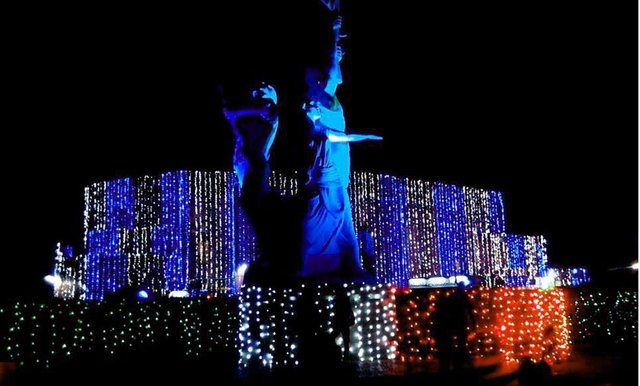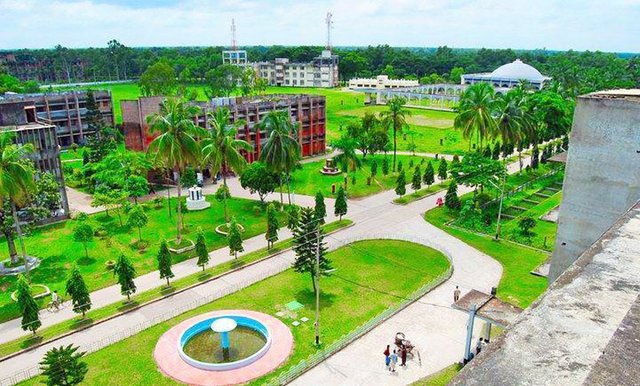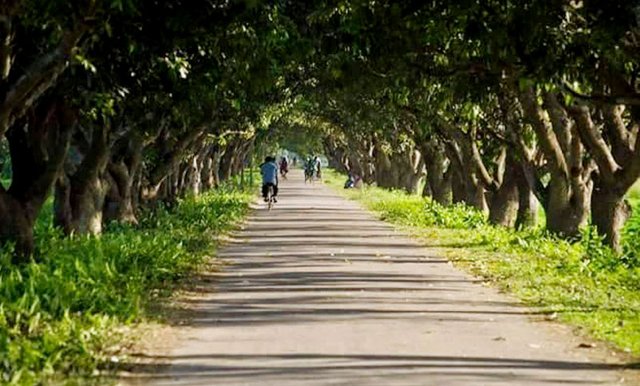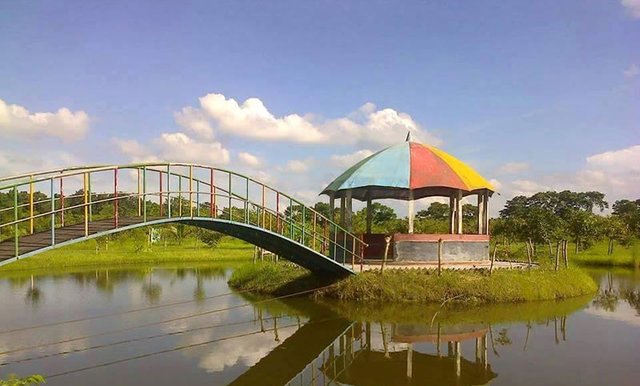
Eat-sand, the busy city prisoner on the wall of dhulamakhala, who sometimes do not want to run away from the racket of life? But it is not always possible to escape. Our lives are captured in various limitations. If you have one day of passing this limitation, then revisit it. Those who are located in or around Dhaka can easily come back from the premises of the 1200 acres of Bangladesh Agricultural University (BHU) campus in Mymensingh. The natural beauty of this campus situated on the bank of the Brahmaputra River will fascinate you. Rail line has gone through the campus. So get out today without delay. Looking at the swirling campus, every place seems like a nursery or a forest.
The campus has botanical gardens, world class grapplazzom center, liberation war memorial Bijoy-71 ', massacre memorial monument, Shaheed Minar, Nadar Para, Baishakhi Chattar, large central mosque of one domed country, country's only agricultural museum, fish museum, two research institutes of the country Main Center- Bangladesh Fisheries Research Institute (BFRI) and Bangladesh Agricultural Research Institute (Bin), mango gardens, litchi gardens, coconut gardens, banana gardens, huge water tanks, 6 faculty buildings, two administrative buildings, student-teacher centers, graduate training institutes, central library buildings, central laboratories, two thousand seats Artist Jainul Abedin Auditorium, Syed Nazrul Islam Conference Hall, Engineering Building, Guest House, and a renowned modern facility. 13 buildings, stadium, gymnasium, Ishan khal lake, health care center, faculty corridor, Bangabandhu Square, Prem Baranda, Maran Sagar, Dormitory, 13th floor, 657 residential units, 12 firms, field lab, clinic, Community Center, Agricultural University College (KB College), Agricultural University High School (KB High School), Night School, Muktijoddha Smruti Primary B Significant parts of Daliyas include
Agricultural University College
If you enter the main entrance of the university, the first life will be born in the soft environment of the entire natural environment. Admitted to the main entrance, the adjacent tidy campus is surrounded by the College of Agricultural University (KB College).
The massacre of the massacre is closed
If you can cross the KB College, you can see the university club, community center, massacre memorial monument in Brahmaputra Nad on the banks of the left hand.
Baishakhi Square
A few steps away from teachers' residential areas, with the main road, Baishakhi Chattar, on the left side of security zone-1, The complex is spread over the banks of the river. You can take a little rest on the banks of the river banks. To celebrate the first year of Baishakh. On that day, there was a small meeting. The students are here to gather in the nanassage crowd Boishakhi songs are also in the mix.
Victory-71

Come on with the main road. After completing four halls of the Kamal Ranjit Market (KR Market) teachers' residential area, the faculty of the War of Liberation will be seen in front of the Vice Chancellor's residence, Vijay-71. This is an important sculpture of the university. A pleasant atmosphere surrounded by flowers around. You can take a picture here to retain memories.

You can get lost on the streets of the embankment
Read More FREE Train Travel!
Botanical Garden
It is the number one of Bangladesh in terms of extinct plant species. The rich botanical garden has been developed in a pleasant atmosphere at the Brahmaputra River on 25 acres of land near the collection of rare trees. The place to sit on the banks of the river. On the campus of the botanical garden, the greenery and the ruckus of the birds will remove the urban fatigue. There are a total of 600 species of trees here. There are thousands of large trees, 1,788 medium and 4,471 small shrubs. As a result, this gardens have to be managed by 30 zones. The names of the zones are also given. Such as herbs, flowers, fruits, cactus, orchids, palm, spices, timber, bamboo, cane, rare, woody plants etc. There are rock gardens for plants that grow in water gardens, desert and rocky areas for aquatic plants. There are extinct and rare cactus collected from various parts of the country, in the cosmos building in the cosmos building.
The Orchid House is right in the south. Sundarbans zone has the Sundarbans trees. Even there are beautiful trees, gaiwa, garana, keora, cattle, bone, hogala and fern trees. There are rare and extinct cactus rows in the cosmos building. A special collection named 'Pot House' contains horse-pods, snake-head, sweet-smelling, purnanava, kurchi, bacha, reverse-eyed, arjunum, anjan etc. varieties of medicinal plants. There are fragrant varieties of plants. Various kinds of fruit trees in the garden include star apples, American guava, Thai beta etc. Flowers include Cobbitam, Rondelchelia, Palam, Camellia, African Tulip, Ribeli etc. Among the extinct plants are Raj Ashok, Naglingam, Kalabus, Carilif, Falasa, Mongota, Makki, Banvubi, Lohakat, Udal, Panilisa, Tekoma, Bera, Hariqki, Kantasingra, Malaria, Papyrus, Rupilia, Stavia, Hing, Pelto Forum etc. There are also Padma Shapala jhal, artificial island, coconut corners, extinct bamboos etc.
While visiting so many trees, there are animals and birds in different places for man and nature. Tigers, lions, two swans and two cranes in the island zone, deer under the arcadeia tree near the main gate. There is a bench for rest in the vicinity of the garden. People coming to the river banks tell stories there. They also saw their boat waving in the river. The garden is open from Robi to Thursday from 2 pm to 5 pm and on Friday and Saturday from 9am to 5pm. The only entry to the botanical garden at the university was 5 taka. No fees are charged anywhere. There is no fee for university students.
Faculty corridor
There are six faculties through a beautiful corridor. The campus can be called corollary and can be said. You can also walk around the corridor.
Agricultural museum
The Octagon Museum with a volume of 620 square meters. There is a total of 2 office rooms and 6 decorated and pleasant rooms for the exhibition, for the office entrance lobby, leaving the middle part of this lovely building open for sunlight. This museum used in the exhibition is the first and only Agricultural Museum in Bangladesh. This museum named 'Agricultural Museum' has been preserved in bamboo and cane made baskets, wacha, mathla, bamboo baskets, turang, kurum, tarra, canal, cowhook, hookah, chaluna, kula and duli. There are also plowshaw, yoke, ladder, spade, da, hoe, kasit, dhaekki, palo, Cheng, outer, voodoo and sanki.
Other types of soil, including the Chinese soil, clay soil and loamy soil of Bijoypur have been preserved in the museum. In addition to various types of fertilizers, rice, jute, pulse, gram, mustard, tomato and nuts, which were invented by the Bangladesh Agricultural School, Nuclear Agriculture Research Institute and other agricultural research institutes, have been preserved in this museum. There are more varieties of grains, extinct fish. Various models of agricultural work, including soil testing equipment (soil testing kit), insulating collection box and hill farming have been preserved. There are many wild animals skeletons with oysters. Apart from Saturday, the week is open from 9am to 5pm daily. No fee is taken for entering the museum.
Fisheries Museum
In the natural environment, in the natural environment, the museum is located about one kilometer from the west of the Faculty of Mathematics and the diversity of the largest fish museum in Southeast Asia. In the scientific way and with modern facilities, decorations and fish are preserved in the museum. The museum at Dotala is located in the main collection. In order to get to the museum, you will first see the list of fish in different classes, many old bamboo mats below the stairs. Our country's heritage is the home of the birds, fishing equipment. Many known-unknown people can learn a lot here.
The last fourth gallery is particularly fascinating. Here is the collection of fossils of extinct fish and other species of prehistoric era. These wonderful fossils have been collected from the United Kingdom with the help of Starley University. There are 40 fossils and skelets in this gallery. The museum is open for two days a week from 8am to 12pm on Friday and Saturday. It's all for everyone and does not require any tickets for entry.
Germplasm Center

In US-DARS study of America, it is the largest and largest collection of the world's largest fruit tree in Bangladesh, Asia. The center is a challenge to the country's 16 million people. And with this challenge, Bangladesh Agricultural University (BHU) is working to make the country more prominent in the country. The fruit museum was established on 1 acre in 1991 with the help of the Swiss Agency for Development and Cooperation in collaboration with bacteriophage department for the protection of fruit gene conservation, education, research and training center, to protect fruit hidden nutrition and to improve the socioeconomic status of farmers. Then its name was Fruit Tree Studies. Later, the project was named after the fruit tree development project. Whose current name is the fruit tree's germplazam center and its current area is 32 acres. Here in the month of jam, there are numerous raw fruits in the dwarf trees that see water coming in the tongue. Thorny-like trunk, flame-like eyes and dragon's appearance are similar. Cutting on the neck, the cactus family is a fruit dragon! It sounds like the monster of the orthodox fairytale. No, it is not as a monster, but it will be known as fruit. There are thousands of interesting species of not only the dragons, but also the rare country-foreign fruit trees, standing on the tree, lying in the open sky bundle a thin flesh.
Nard border
The Bangladesh Agricultural University grew up on the banks of the ancient Brahmaputra river. The main road on the left side is the whole of the river. So you can get tired of going on the banks of the river. There is a bar sitting on the brick field with occasional brick benches. If you wish, you can spend the afternoon in the boat.
Isha Khan Lake, Lalon Square and Low and Down Bridges If you want, you can sit on the banks of the lake. There is an open square on the lake bank. The name of the complex is named Lalon Square. To take pictures, you can go to the Low and Down Bridge adjacent to GTI. It is here more commonly known as the London Bridge.
Horticulture Center and others
You can enjoy the beauty of flowers on campus premises. You can walk on the railway line and take a little while. Or litchi gardens, horticulture center, mango gardens, banana garden can walk freely through the road. You can sit on the banks of the Bangabandhu Square facade or on the banks of the river and enjoy the beautiful time.
Eat and drink
Jabbar junction, railway line, KR market at the university premises and there are many food hotels in Karim Bhawan. All the hotels will always find you fish, meat, bhcha rice, and all of them at cheap prices. TC can eat and eat. In addition to the campus, there will be fossil gear around the city, many hotels shops will be available in the market. If you want to return home, you can bring special delicately sweet from Mymensingh city. The famous Ma-Moni suites and black cabin for Malaiika.
How come
A few buses left from Mohakhali bus terminal leave every 15-20 minutes. It will take two to three to three hours. In this car, the rent will be 220 taka. Apart from this, other Shyamoli Bangla, Alam Asia, Islam etc. will cost around Tk. 120. You can also go by train. Come to Mymensingh and bring down the masakanda or bridge. Auto to come to the campus from Mascanda will cost a maximum of 20 taka. The bridge will cost 10 rupees to the auto
Hi ~ I'm a robot of betty007.I just upvoted your post!
Please also help upvote my post here: https://steemit.com/@betty007/5tqs5v
Thanks so much~!!
Downvoting a post can decrease pending rewards and make it less visible. Common reasons:
Submit
fvd
Downvoting a post can decrease pending rewards and make it less visible. Common reasons:
Submit
amazing scenery
Downvoting a post can decrease pending rewards and make it less visible. Common reasons:
Submit